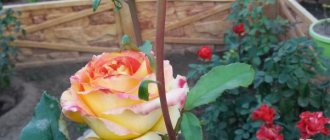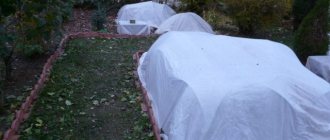Floribunda roses are very popular among gardeners. The reason for such love is the long flowering and relative unpretentiousness of this type of rose. We want to introduce you to the most important rules for caring for floribunda roses.
Roses don't like amateurs. If you are going to place a capricious beauty in a flowerbed, in the front garden, or to set up a rose garden on your property, you first need to learn the rules for caring for a rose. Everything is important here: how and when to plant it, how to prepare the soil, at what time to fertilize it, how often it needs to be watered and pruned, how to prepare it for winter. A mistake at any stage can result in the death of the plant.
We have prepared 9 rules for caring for floribunda to help the novice gardener.
The first floribunda roses were created at the beginning of the last century. These beauties turned out to have two “fathers”: some sources name the name of Peter Lambert, others – the Dane Poulsen. The plant appeared as a result of crossing polyanthus and hybrid tea roses. From the first, the floribunda inherited resistance to disease and frost, and from the second, a very beautiful bud of multiple shades. But the creator of the modern floribunda rose is considered to be the American breeder Eugene Berner.
Rule No. 1: choose high-quality planting material
How to choose the right rose seedlings? When choosing planting material, pay attention to the following points:
1. Rose seedlings can have an open or closed root system (sold in pots or in bags with a small amount of soil). Each of them has its own advantages:
- Seedlings with ZKS can be planted in the ground throughout the warm period of the year, until late autumn. In addition, they take root better and faster than bare-root roses.
- Seedlings with ACS have open roots, so it is clearly visible how developed the root system is, whether there are rotten or dry roots, etc., and they are cheaper than seedlings in pots.
2. Manufacturers often fill the stems of seedlings with wax. In this state, in a room with a low temperature, they can be stored for quite a long time. However, after the purchase, it may turn out that you were sold a cutting that will never wake up. To find out if roses are alive, carefully remove a piece of wax. If there is a green, healthy stem underneath, you can safely buy it. Some rose growers prefer to buy cuttings with green leaves that have already hatched: once the leaves appear, it means the seedling is alive.
3. Pay attention to the age of the planting material. The best option is two- and three-year-old seedlings with a well-developed root system and several (at least 2-3) stems.
It is best to buy rose seedlings from trusted nurseries. This way you will save yourself from disappointments, and your family budget from useless expenses.
4. Don't make rash purchases. When going for rose seedlings, study the information and make up a clear “portrait” of the rose you want to purchase: the height of the bush, the size and shape of the flowers, flowering time, disease resistance, etc. This will save you from buying, for example, a 3-meter beauty that there is simply nowhere to place it on your site.
What is floribunda
History of the origin of the variety
It is still not clear which of the two breeders - the Dane Svend Poulsen or the German Peter Lambert - is the author of the floribunda, but this hybrid appeared as a result of crossing hybrid tea and polyanthus roses. And the creator of more than sixty modern highly decorative varieties of floribunda, which are grown today all over the world, is the American scientist Eugene Berner.
Botanical description
From polyanthus roses, floribunda inherited a richness of colors and bud shape, and from hybrid tea roses - resistance to low temperatures, various diseases and pests. The diameter of flowers of this class reaches 4-8 cm. Simple, double, semi-double and densely double flowers can have a goblet or cup shape.
Floribunda bushes are characterized by a bouquet type of flowering, when many flowers form a large inflorescence. These roses bloom for a long time, abundantly, but in waves: the period of mass formation of flowers is replaced by a period of less intense flowering.
- Nivyanik: growing from seeds, types and varieties
Plants of this class are striking in their variety of colors. A relative disadvantage of some varieties of floribunda is the lack of scent in the flowers. According to the height of the bush, varieties are divided into border varieties (up to 40 cm in height), medium-growing (from 60 to 80 cm) and tall-growing (from 1 m and above). Floribundas are planted along borders, as a tapeworm on lawns or in group compositions with ground cover and perennial herbaceous crops.
In the photo: Pink rose Floribunda
Rule #2: Plant at the right time of year
In the middle zone, the ideal time for planting roses with an open root system is May-June, when the earth has already warmed up well.
Residents of the southern regions of Russia can plant roses in the fall (mid-September - mid-October) - the plants will have time to take root before the onset of frost. In the northern regions and the middle zone, autumn planting of roses rarely ends successfully. And all because frosts can strike suddenly and the rose will go to winter without taking root. Most likely, such a plant will die from the cold.
Roses with ZKS, as mentioned above, can be planted throughout the entire growing season.
Use Cases
The space looks gorgeous no matter where exactly you decide to plant it. It is appropriate in a large flower bed and in a mixborder, alone against the background of a green lawn or low-growing grasses with inflorescences of contrasting shades, in rockeries. Decorative flowering shrubs are used to decorate low hedges, garden paths, and to divide a site into zones. A rose with buds of delightful color can be placed near a gazebo, garden bench, or sculptural composition. Plants with red, orange and bright yellow buds will be good neighbors for the crop. This way the European beauty will stand out from the total mass of specimens that make up the floral ensemble. A harmonious composition can be obtained by combining this variety with miniature conifers, clematis in pastel shades, and silver wormwood.
Rule #3: Use a well-lit area for planting.
Floribunda roses love light, so for planting it is important to choose a well-lit place (south, southeast or southwest side of the site), protected from drafts. To prevent the buds from burning out and drying out prematurely, be sure to shade the bushes in the midday heat.
When planted in a shady place, roses may stop blooming altogether, and black spots will appear on the leaves. And powdery mildew, which also appears in a shady and damp place, can greatly spoil the life of both you and the plant. Roses also do not like close proximity to groundwater.
Roses have no special preferences regarding soil - the main thing is that it is breathable and loose. If you have clay soil, add sand or peat to it, and if sandy, add organic matter.
History of origin
The culture appeared in Germany, where it was developed famously. This company is a large rose nursery founded by Wilhelm Cordes I back in 1887. Our heroine is the result of selection in 2006. Already in 2007, she became the owner of the ADR mark. In addition, over the course of two decades of its existence, the variety has repeatedly received medals at various flower competitions. In particular, 2009 brought the noble plant First Prize at the Hradec Kralove event in the Czech Republic. Other names of the variety: Kosmos Fairy Tale, KORpriggos.
Rule #5: Plant roses according to the rules
The planting process is the most responsible, but at the same time it is not at all complicated. So, you have prepared the planting hole. What to do next?
- Sprinkle it with plenty of water.
- Place a layer of drainage at the bottom of the hole: expanded clay, small pebbles, etc.
- Pour half a bucket of the prepared fertile mixture into the hole, forming a small mound.
- Place the seedling in the center of the mound.
- Gently distribute the exposed roots over the free area.
- Cover the roots with fertile soil, carefully compacting it so that there are no voids near the roots. After planting, the root collar should be 3-5 cm below the soil surface. When planting roses with ZKS, make a depression in the planting hole and lower the rose into it along with a lump of earth (pre-moisten the soil in the pot well so that it does not crumble).
- Water the plants generously around the edges (not at the roots!).
- After the water is absorbed, be sure to mulch the tree trunk circle with peat, straw or expanded clay.
Plant floribunda rose bushes 50cm apart.
How to care for a plant?
Caring for roses grown from cuttings is not at all difficult. It will be enough to regularly moisten and feed the soil around the growing plant. Watering should be done daily, but do not over-moisten the soil. Excess liquid can cause rotting of the plant's root system.
The soil must be loose. To do this, you can add perlite, sawdust, vermiculite or sand with large grains of sand to the soil.
Only those seedlings that have reached 12 centimeters in height need to be fertilized. It is recommended to use products that contain magnesium, nitrogen, calcium and phosphorus as fertilizers. You can also use herbal infusions and mullein.
In order for the rose bush to be strong, in the first year it is necessary to remove flower buds as soon as they form. Then the plant will be able to form healthy stems.
Rose bushes need to be covered for the winter. This will protect the crop from freezing. It is worth noting that some types of flowers must be dug up and stored in a damp and cold place.
As you can see, growing a rose from cuttings and then transplanting it into a pot or open ground is not at all difficult. The main thing is to take care of the flowers, regularly moisten the soil, apply fertilizers and cover the bush for the winter. If you properly care for your rose, it will bloom beautifully and luxuriantly, decorating your garden landscape.
You can learn more about how to grow a rose from a bouquet from the video below.
Rules for watering and fertilizing
Propagating roses by layering in the summer is considered a popular method, but the result can be negative if you do not properly care for a bush that has already taken root. Basic rules for caring for a rooted bush:
- You need to carefully monitor the condition of the soil - the ground should always be moist. In this case, you cannot flood the plant. If you overdo it, the root system may rot.
- Periodically you need to apply organic and mineral fertilizers, which are individually designed specifically for roses. Be sure to follow the instructions on the package - the correct dosages are indicated here.
- If yellow or limp leaves appear on the bush, they need to be torn off. This will help strengthen the trunk itself without wasting nutrients to ensure the growth of already “damaged” leaves.
- If pests appear on leaves and trunks, spray with the appropriate substance.
Additional Information! A climbing rose also requires the installation of a support so that the branches do not lie on the ground, but are located spaciously on the mounts.
Watering a rose bush
Naturally, in the process of preparing for winter, it is worth considering a way to insulate the bush. This is simply necessary in order to save the plant from frost, since they are completely frost-resistant.
To expand the park area on a summer cottage or private plot, forming a beautiful rose garden, it is worth propagating shrubs yourself. The best option would be cuttings. There are several ways to breed flowers this way. Thus, you can grow any variety of roses: floribundas, shrubs, climbing roses and any others. There are a number of recommendations regarding the care and maintenance of shoots that take root in the summer.
How to store for the winter?
To preserve the viability of cuttings throughout the winter, you can use the following methods:
- landing in the ground;
- rooting in moss;
- storage in a pot;
- cold storage.
When using moss, it must first be treated with Fitosporin, then the rose branches should be wrapped in sphagnum moss and a sheet of newspaper. Seedlings should be stored in a cold room until spring.
If the seedlings will be stored at home, then planting in the soil is suitable. To do this, do the following:
- Pour the substrate into the pot.
- First moisten the stems in water, then in a growth stimulator and plant them in the soil.
- Cover the container with planting material with a warm blanket and take it out onto the balcony.
- Cover the seedlings with a bag. Before frost arrives, the soil must be moistened and ventilated.
With the arrival of severe frosts, you will need to either take the container with the cuttings to a warm room, or cover the stems with jars, as in the photo below.
Rule #6: Pruning on time
Pruning floribunda roses stimulates abundant flowering and the growth of basal shoots. Some shoots are pruned heavily, while others have only a small part of the stem removed.
Pruning of adult floribunda rose bushes is carried out 3 times a year:
- Spring pruning: after planting, in subsequent years - before the start of sap flow (in the first half of April). Shorten all one-year-old shoots of bushes by a third, and leave 3-5 buds on two-year-old ones. Also, during spring pruning, you can completely remove old shoots that thicken the bush.
- Summer pruning: its purpose is to stimulate flowering. Remove all faded inflorescences from the plant.
- Autumn pruning: remove old, undeveloped branches and leaves for successful wintering of the rose.
Rule #7: Don't overwater
Roses love water. Water them once a week. In hot weather, do this twice as often. One adult bush will need a bucket of water.
Water your roses in the early morning or evening. Pour water not to the roots, but into a small ditch dug at a distance of 10-15 cm from the stem. When watering in the evening, try not to get water on the leaves of the plant - this can lead to fungal diseases. Sprinkling the rose can only be done in the morning so that the moisture has time to dry out during the day.
During the period of rapid development (when buds and leaves appear), as well as after the first flowering, watering is especially important. At the beginning of autumn it must be stopped, otherwise the rose will continue to grow and will not have time to prepare for winter.
But at the end of October, on the eve of a cold snap, carry out moisture-charging watering: the plant should saturate the roots and stems with moisture to make it easier to withstand winter frosts.
Rule No. 8: Feed your roses in a timely manner
It is very important to fertilize roses correctly throughout the year. You need to start fertilizing from the second year of the plant’s life.
- After pruning, before the leaves bloom, and two weeks after that, feed the roses with ammonium nitrate (30 g per 1 sq.m.) or organic matter: mullein diluted with water (1:10).
- During the period of bud formation, roses will benefit from a complex mineral fertilizer for flowering plants, such as Agricola or Fertika.
- Before the first flowering, feed the roses with mineral fertilizer: dissolve 1 tbsp in a bucket of water. potassium sulfate, the same amount of Agricola rose fertilizer and 2 tbsp. nitrophoska.
- After the first flowering, feed the roses with complex mineral fertilizer (see the dosage on the label). Remember that from August you should not feed plants with nitrogen fertilizers.
- In autumn, fertilizing with potassium salt and superphosphate (30-40 g per 1 sq.m.) is acceptable. Fertilizers during this period should not contain chlorine.
Feeding and fertilizers
Newly planted roses begin to be fed no earlier than June. Old bushes are sprayed along the stems in the spring, immediately after opening, with biological products that help plants recover after wintering (Epin-Extra, Zircon, NV-101).
Solutions of nitrogen (urea) and organic fertilizers (infusions of mullein, bird droppings, nettles and other herbs) are given under the root to actively increase the vegetative mass.
| Tip: In May, it is useful to spray roses with Immunocytophyte to stimulate plant development and protect them from diseases. This treatment is repeated after 20 days. |
In June-July, potassium-phosphorus fertilizers begin to be given; ash can be used instead of potassium. Monopotassium phosphate is also suitable; it contains 55% superphosphate and 35% potassium in soluble form. This fertilizer gives excellent results. It will not hurt to use the drug Potassium Humate with microelements, both for root and foliar feeding.
In August, watering, fertilizing and loosening should be reduced so that drying the soil will promote better ripening of rose stems before winter. At the end of the month, you need to cut out all the faded inflorescences so that the seeds do not set, and those that appear by the end of September should be left, because the rose ripens better when the seeds are set.
Rule #9: Cover your roses for the winter
Roses should be covered for the winter. Start preparing bushes for winter hibernation in mid-October. Before the shelter, autumn sanitary pruning is carried out, during which it is necessary to remove leaves, unripe buds and shoots - all this is burned.
Then, for preventive purposes, treat the roses with 1% Bordeaux mixture or 3% iron sulfate. Remember that treatment with iron sulfate can be carried out only after there are no leaves on the rose in order to burn the leaf blades.
Give preference to air-dry covering of roses. Before you cover the plant, do not forget to insulate the roots: pour a layer of peat or soil (20-30 cm) under the bush.
A little care and attention - and the floribunda will definitely bloom long and profusely, delighting you with its unique beauty.











